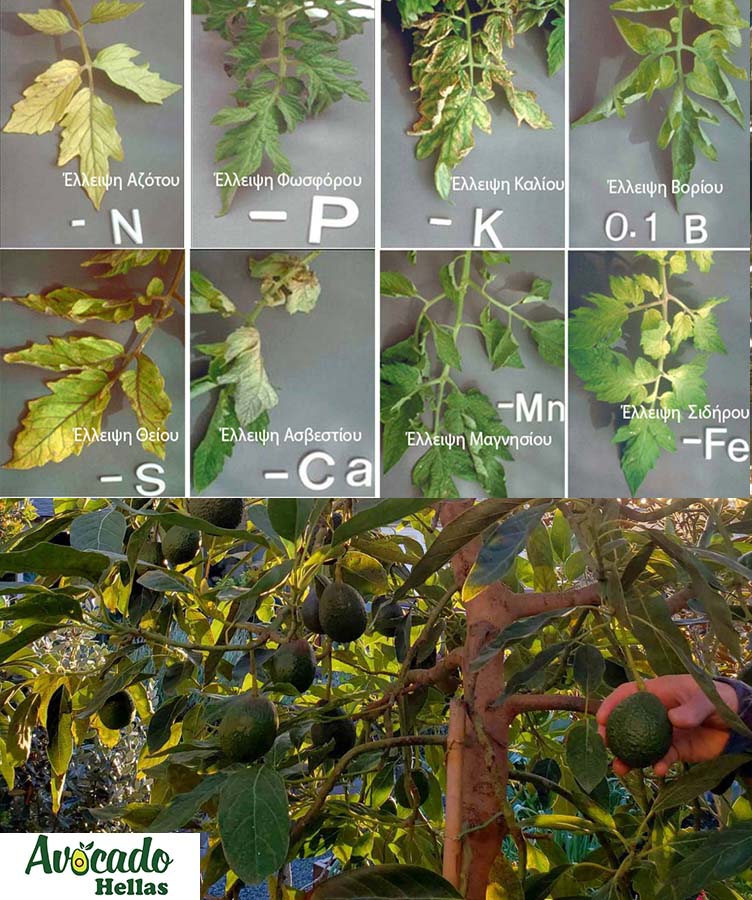Avocado Lack of Trace Elements-Symptoms of nutrient deficiency

Symptoms of nutrient deficiency
Plants need nutrients to grow.
The non-mineral nutrients of plants are:
hydrogen (H),
oxygen (O), and
carbon (C).
These nutrients are found in air and water.
Avocados Lack of Trace Elements The other nutrients come from the soil.
Soil nutrients are divided into two categories according to the quantities required by the plants.
Macroelements and micronutrients (trace elements).
The macronutrients are nitrogen, phosphorus, potassium, calcium, magnesium and sulfur.
The trace elements that need only trace elements are iron, manganese, boron, zinc, copper, molybdenum and chlorine.
These nutrients are essential for plant growth.
The plants will grow normally until they run out of one or two nutrients at a time.
Then growth will stop from lacking them.
If the nutrients are deficient or too abundant, then the plants will be deformed and have a damaged color.
The yellow leaves e.g. can be caused by one or more nutrient deficiencies.
It is much better to do a soil or leaf analysis to show which nutrients are low before you start a crop.
Primary macroelements.
• Nitrogen – Nitrogen (N)
• Phosphorus – Phosphorus (P)
• Potassium – Potassium (K)
Secondary macroelements
• Calcium – Calcium (Ca)
• Magnesium – Magnesium (Mg)
• Sulfur (S)
Microelements
Indicatively some small elements
• Boron-Boron (B)
• Molybdenum Deficiency – Molybdenum (Mo)
• Iron (Fe)
Avocado Lack of Trace Elements Primary macronutrients
Nitrogen-Nitrogen (N) Deficiency
Generally
It is a primary nutrient for plant growth.
Plants convert nitrogen into essential proteins for the growth of new cells and chlorophyll.
Tomato flowers or fruits can rarely be affected.
Symptoms
Sick plants, red stems, slower growth.
Rapid yellowing of the lower leaves, a phenomenon which progresses to the top of the plant.
The disease is caused by the Adelomycete Mycorellosiella fulva.
Treatment
Add Nitrogen-containing fertilizers.
With proper treatment the plants will recover in about a week.
Phosphorus-P deficiency (P)
Generally
It is essential for photosynthesis and acts as a catalyst for energy transfer within the plant.
Phosphorus helps build a healthy and strong root system, it is also a vital ingredient for flowering and seed production.
a. Symptoms on the leaves.
Reduction of growth rate, red stem.
The smaller leaves are dark green-blue.
The lower leaves turn yellow and wither.
Excessive phosphorus availability can cause potassium deficiency.
b. Wrist symptoms.
Blotchy Ripening on the tomato fruit.
Green and yellow areas (like a mosaic) appear on the surface of the red fruit.
Treatment
Add Phosphorus-containing fertilizers.
Leaves that have already been affected will not recover but the new leaves and growth will continue normally.
Potassium Deficiency (K)
Generally
Activates the production and circulation of sugars and starches, as well as growth by cell division.
Symptoms
Deficiency is usually more pronounced in tall plants, which show necrotic spots on the lower leaves and the stem is red
The leaves are pale or yellow and their edges turn brown and turn upwards.
Treatment
Add fertilizers containing Potassium.
Secondary macroelements
Calcium Deficiency – Calcium (Ca)
Generally
It helps in the structure of the cells and is necessary for the strength of the plants
a.Symptoms in the strains.
The young tips of the plant die. Tomato stalks begin to dry starting at the edges.
The leaves die, starting with the new leaves and shoots that are fertile and contain flowers.
b.Symptoms in the Network – Zeukton
The extreme leaves and flowers are dried. The leaves acquire red-brown shades.
c.Symptoms on the Wrist.
Dry or black top of the fruit (Blossom End Rot).
The grids are drying.
The dry or black top of the fruit (Blossom End Rot) appears on the extremities.
Treatment
Treat with foliar fertilizer, use a teaspoon of Dolomite Lime in 1 Liter of water and spray the leaves 1-2 times a day, until you see the condition improve.
Magnesium Deficiency – Magnesium (Mg)
Generally
Require as part of chlorophyll for photosynthesis.
Production decreases and the old leaves turn white or yellow
a. Symptoms on the leaves.
Central chlorination and green bands at the edges of the leaves.
b. Symptoms in the Network.
Central chlorination and necrosis of the leaves. The fruits (tomatoes) show “green backs”.
c. Symptoms in the plant.
Appearance in greenhouses. Central chlorination and necrosis of the leaves.
Treatment
Add Magnesium to the water / solution very carefully
Sulfur Deficiency – Sulfur (S)
Generally
It participates in the synthesis of proteins and is part of the amino acids, cystine and thiamine, which are the building blocks of proteins.
It has an active role in the structure and metabolism of plants.
Symptoms
Plants suffering from sulfur deficiency, show yellowing in the new leaves accompanied by small mutant leaves which are round in the shape of a roll, then the yellowing extends to all the leaves.
The leaves become hard and brittle.
Treatment
Rainwater, plaster
Microelements
Lack of Boron-Boron (B)
Generally
Helps in the production of sugar and hydrocarbons.
It is Ideal for seeds and fruit growth
a. Symptoms on the branches.
The stems become rigid.
New flowers die and growth is reduced.
The lateral branches grow, preventing the plant from growing in height.
The leaves acquire a strong need of purple, brown and yellow.
b. Symptoms in the wrists.
The fruits of the tomato have no seeds and have a corky texture.
Maturation is not uniform.
Treatment
Organic material and borax
Molybdenum Deficiency – Molybdenum (Mo)
Generally
helps build protein and enhances the plant’s ability to absorb nitrogen from the atmosphere.
Symptoms
The leaves are somewhat chlorotic.
Intense rotation of the leaves.
The leaves are dried from the edges.
Treatment
Treat with foliar fertilization using Molybdenum-containing fertilizers.
Iron (Fe) Lack
Generally
is a basic catalyst for the production of chlorophyll and is used in photosynthesis.
Symptoms
The leaves turn yellow or white while the glands remain dark green.
PH imbalances lead to non-absorption of iron by plants.
Treatment
Treat with foliar fertilizer using Iron-containing fertilizers.
Always use Iron Chelate so that it is immediately available to plants.
